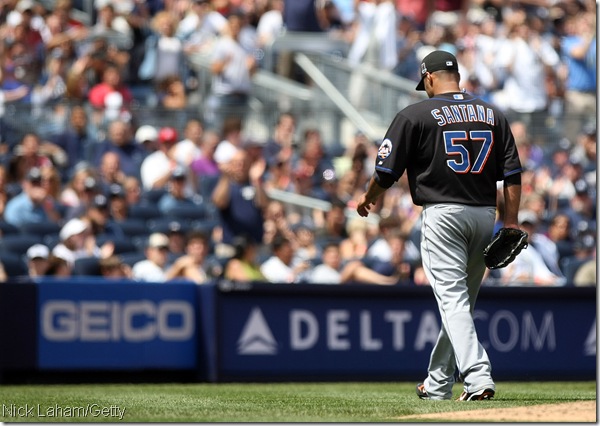 Other sources – like Baseball Prospectus – have started to pick up on our idea of the Mets’ season being like a horror movie. Being that we are horror movie historians of sorts, we’ve specified the movie Final Destination as a direct parallel. And following with that theme, whatever demonic force has targeted the Mets claimed Johan Santana’s valuable left elbow and Oliver Perez’s somewhat less valuable right knee this week.
Other sources – like Baseball Prospectus – have started to pick up on our idea of the Mets’ season being like a horror movie. Being that we are horror movie historians of sorts, we’ve specified the movie Final Destination as a direct parallel. And following with that theme, whatever demonic force has targeted the Mets claimed Johan Santana’s valuable left elbow and Oliver Perez’s somewhat less valuable right knee this week.
Sidebar: If there’s anyone out there who thought 150-year-old malcontent Gary Sheffield would outlast Santana, much less Wright, Beltran and Reyes, he or she should promptly begin playing the horses.
Regardless, neither Santana and Perez will pitch again this season, bringing to an end a series of injuries that veered into the land of the occult.
However, these two most recent maladies, particularly that of Santana, brings to attention a couple of shortcomings of the Mets’ organizational strategy.
- Pitchers are too risky to make big-money investments in.
- There is great monetary value in a successful scouting department and farm system.
Suffice it to say we talk about baseball a lot where I work. And I have a respected and esteemed colleague who has said for years as a motto: “All pitchers are injured.â€Â
- And he’s right. Even healthy pitchers are by definition injured. The act of throwing a ball at speeds upwards of 90 mph requires a stunning amount of torque on the pitching shoulder, elbow and forearm. Much like lifting weights, which creates microscopic tears on the muscle, throwing a ball with that much intensity does the same exact thing. The damage, however, is not always microscopic. And the sheer repetitiveness of the motion will take a small issue and create a large issue before too long.
- In addition, the more innings a pitcher throws, the more velocity and command he loses. It’s like a car; your vehicle won’t perform at the same level after 100,000 miles that it did during the first 20,000.

- And baseball’s salary structure is such that he won’t be eligible for free agency in most cases until several stages have passed in his career, most notably the arbitration years. And teams tend to lock up their young pitchers through that time period anyway, generally at a discount over what they would have to pay out otherwise.
- That, my friends, is why spending big money on free-agent pitchers is a bad investment. By the time you’re getting a player, he’s at least 28 or so, which is how old Santana was when the Mets traded for him and immediately re-signed him to the biggest contract at that time ever given to a pitcher. But while a hitter’s prime is generally looked upon as 27-34, I would suggest that a pitcher’s prime is probably during his arbitration-eligible years.
- As good as Santana has been, including his first season with the Mets, his velocity and strikeout rate were dropping even before they traded for him. Not that they were getting a lemon – he was 9-0 after June last year – but I think it’s difficult to dispute that the marvelous lefty’s best days were behind him, even before he developed bone chips in his elbow that needed to be surgically removed. The Mets did luck out that there was no structural damage, but their ace underwent elbow surgery, which is never a good thing.
- I don’t believe I need to go into the reasons why giving talented but flaky Oliver Perez a three-year, $36 million contract was a bad move.
- The best thing to do is to make sure that you don’t end up in a position where you have to fill in a gap by signing a pitcher, which brings us to the Mets’ second shortcoming, an inability to scout, draft and develop young arms in the Minors.
- The Santana trade was necessitated and accelerated by a 2007 rotation that included way-past-his-prime Tom Glavine, Perez, an already breaking down John Maine, super-ancient Orlando Hernandez, the shell of Pedro Martinez and a not-ready-for-prime-time Mike Pelfrey. If the Mets had been able to develop fresh young talent, they would not have been in a spot where they had to push all of their chips in on Santana. Trading four prospects – who, granted, have not made an impact – and forking over $137 million was a desperate, but probably necessary, move.
- Contrast that to last season’s Rays, who made the World Series on the strength of developed young arms James Shields, David Price, Scott Kazmir and Matt Garza – the last two acquired in trades, Kazmir infamously from the Mets – and you see the value of acquiring, cultivating and utilizing young talent. They lost to the Phillies and homegrown ace Cole Hamels, with a big assist from Ryan Madson, and you see the kind of season J.A. Happ is having. (In addition, some of their other prospects allowed them to trade for Cliff Lee, who may put them over the top again)

- Young, developed talent does not put a strain on a team’s payroll, and while the possibility of breakdown still exists, it’s not as costly as when it happens to an investment such as Santana. The Mets were unable to prepare for the future, and it has cost them dearly.
- Now the Mets face an uncertain future of four more years of Santana. Though it’s a different situation from the Martinez deal, they clearly remember what kind of shape Pedro was in at the end of that contract. They must now hold their breath that Santana, at twice the price, will not proceed further down that road, and the hard truth is that he won’t get younger.
- All of this is why I suggest the Mets must part ways with general manager Omar Minaya, despite the fact that I like him. Minaya has made some good moves and some bad moves, but the most significant shortcoming is his inability to create a solid scouting department and organizational base. I believe he viewed the Mets’ relative economic advantage as his way not to pay attention to those areas, covering up the team’s shortcomings in this area with costly and risky signings.
- With the Wilpons losing a reported $750 million in the Madoff fiasco, the days of fiscal irresponsibility must end. The Mets need to start at the top and put people in place who know how to develop a cost-effective and efficient scouting department and organization. They need to realize that the capital spent to overhaul the front office will save them money in the long run. And they should be a cautionary tale for other teams who may head down the same road.
- Because if a team is unwilling to stay contemporary with its philosophies regarding free-agent pitchers, the Minor League system and scouting department, it will be doomed to relive the same mistakes over and over again.